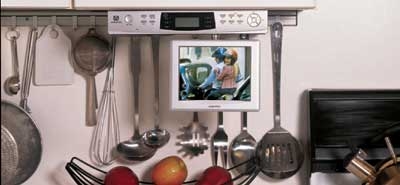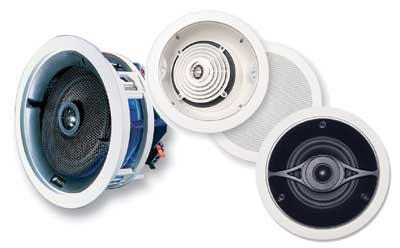Flat TVs for Every Room Page 3
The Kitchen Since the kitchen is the center of the family's social life in many homes, it's a great place for a TV. From getting a quick dose of the news over breakfast to watching afternoon talk shows while cooking dinner, having a TV in the kitchen makes sense. Unfortunately, the typical 13-inch tube TV on the kitchen counter is a space-hogger. Options for under-cabinet mounting free up some space but still leave precious little room to slice vegetables. A flat LCD set mounted under a cabinet is another story, and with the emergence of ever-less-expensive LCD TVs, the entertaining chef has plenty of options among stand- or wall-mounted sets sized 20 inches or smaller.  Audiovox VE640 under cabinet LCD TV ($540)
Audiovox VE640 under cabinet LCD TV ($540)
If the tube TV on the kitchen table is an eyesore, then a 20-inch LCD like Sharp's LC-20E1U ($1,200) is a head-turner on par with Braun's swankiest espresso machine. Its white finish matches most kitchen décors, and to save space its speakers are mounted below the screen instead of to either side. The cable or satellite box still presents installation difficulties, but you could use a hutch on the table or stash the box under the Lazy Susan. Like most of its kind, the Sharp has a built-in TV tuner, so if reception is good you could simply attach a small antenna. If you're lucky enough to subscribe to a cable service that doesn't scramble all of its channels, you can plug the cable directly into the set.
Wall-mounting an LCD is also an option in the kitchen, but you'll find that under-cabinet flat-panel installations are even better since they take advantage of the cabinets' depth from the wall to let you fold the display up. The simplest solution is to mount a small LCD, like Sharp's white 13-inch LC-13E1U ($550), on a flip-down mount. When you're not watching, you can swing the TV out of sight, flush with the bottom of the cabinet. Companies like Chief and Peerless make swing arms and articulating wall arms that can fold the TV around the side of a cabinet or slide it forward from underneath. Kitchen-sized arm mounts accommodate LCDs with 13- to 20-inch screens and do a good job of organizing cables and facing the set toward different areas of the kitchen as needed.
Realizing the potential of the kitchen, innovative TV manufacturers have come up with specialized under-cabinet sets with swing-down LCDs. Audiovox (audiovox.com) offers a couple of under-cabinet models, including the slick VE1040 ($999), which has a 10 3/8-inch screen and built-in DVD player to help you fill the time between episodes of The Iron Chef. A mere 3 1/2 inches thick when closed, this system also sports a clock radio and even a built-in speakerphone. And if chatting on the phone while watching TV isn't enough to keep you occupied in the kitchen, you might want to either pay more attention to cooking, or check out the Beyond iCEBOX FlipScreen ($2,299, icebox.tv), which adds Internet access to the mix.
Nobody wants a bunch of wires running all over the kitchen, so it's important to place your under-cabinet TV as close to an electrical outlet as possible. Gather the slack in the cord and stash it out of sight behind the set so just enough is left to reach the outlet. If you have to use a cable or satellite box, you can place it under the cabinet next to the set or inside a glass-fronted cabinet so the remote control still works. Another solution is to set the box on top of the cabinet near the ceiling so that it will be out of sight but still within range of the remote. Or you could add a simple IR repeater and hide the cable box inside a solid-door cabinet located either above or below the counter.
The best place for the cable itself is inside the wall, of course, but stringing it through there can get expensive, especially if you have lots of tiling. If you have no choice but to leave the cable exposed, run it along the corner between the wall and the ceiling, then down along the edge of the cabinet. Try to avoid running wires near the floor since they can become exposed to beverage and food spills and other domestic accidents. You could also string the cable through the cabinet itself, although that will require drilling entry and exit points.
Perhaps more than any room in the house, the kitchen demands the efficient use of space. Since built-in appliances are the norm, you'll want your kitchen entertainment appliances to be integrated just as efficiently. A flat LCD TV, whether mounted under the cabinet, on the wall, or on the table, is the entertainment equivalent of a magnetic-induction stovetop: stylish, space-saving, and functional.
The Right Sound
The Gen-X set has a radically different take on the kitchen, tending to see it not just as a place for cooking and eating, but also as the house's social hub. New kitchens tend to be significantly bigger than their predecessors and centered in the house's floor plan. Given their newfound importance, kitchens cry out for quality sound, but since space is still at a premium there, traditional speakers just won't do.
Kitchen walls are typically covered with large cabinets, and countertops are filled with appliances or are needed for food prep. Finding a speaker that delivers the audio goods while taking up virtually no space can be daunting. One option is to use wall- or ceiling-mounted minispeakers. These fit the bill aesthetically but can sound anemic if not paired with a subwoofer to handle the low end. If you have some dead space above your cabinets, however, a subwoofer/satellite combo, or small bookshelf-style speakers, can fit the bill.
Or you could go with in-ceiling speakers. Available from nearly every speaker manufacturer, these often provide the perfect solution to the space vs. sound dilemma. In-ceiling models are a focal point of companies like SpeakerCraft (speakercraft.com), Niles (nilesaudio.com), and Sonance (sonance.com). All three of these manufacturers offer a tremendous range of good-sounding speakers that can accommodate just about every budget. To get even better sound, you'll want to install the speakers using acoustical enclosures, or back boxes, which can reduce ceiling vibrations and tighten up the bass. (This complicated and messy job is often best left to a professional installer.)  Niles Directed Soundfield 6.3 ($275), Speakercraft AIM Five ($750), and Sonance Merlot 421 MR ($100) in-ceiling speakers. The woffers and tweeters in the Niles and SpeakerCraft models can be aimed individually at the listening position.
Niles Directed Soundfield 6.3 ($275), Speakercraft AIM Five ($750), and Sonance Merlot 421 MR ($100) in-ceiling speakers. The woffers and tweeters in the Niles and SpeakerCraft models can be aimed individually at the listening position.
Getting the audio signal to the speakers can be tricky. In many cases, the kitchen is part of a house-wide audio system, whether as a zone by itself or grouped with other rooms. This allows all of the amplification and source components (CD player, satellite radio and TV receivers, and so on) to be located elsewhere. At a minimum, you should install a volume control in the kitchen so you don't have to take a hike to your A/V receiver just to nudge the volume up or down. But if your budget allows, you should definitely splurge for a keypad controller, which offers a lot more interactivity with your system, such as selecting CDs, changing radio stations, and so on. - J. S.




























































